relevent/ marketing ideas

Read on to see the ways you can take advantage of LinkedIn Pulse in your event marketing.
By using Pulse to publish informative, useful articles under either your name or the event’s name, you position yourself as an expert in your field. You can interview experts, use authoritative sources, and add statistics to give your credibility a boost. For the Conference of Metallurgists, we used LinkedIn Pulse to share interviews with a diverse group of participants in hopes of encouraging potential newcomers. We interviewed a student, a former president of the association, and a consultant who each gave their own take on what the conference means to them. Community stories like these will resonate extremely well with your audience!
All your connections get an alert when you publish an article on Pulse, making it a great promotional tool. Use it to make important announcements, such as the announcement of your speakers and program. It is an opportunity to explore long-form content, so let your passion shine with valuable, specific, and media-rich content.
Headlines and graphics are key to success on Pulse. Make several drafts of your headlines that use different emotional appeals, and run them through an analyzer to determine which one will perform the best. For your graphics, keep in mind that that 16:9 is an ideal image size for the cover, and inserting images every 75-100 words in your article can give engagement a serious boost!
The article you post should offer a solution to a problem, or information that is helpful in some way, just like a blog post. It should link back to your website and integrate a call-to-action to be really effective. There’s another benefit to Pulse posts: it turns out that they are rich in SEO value because LinkedIn is the 25th most visited site in the world, and Google is more likely to index this content.
Your most recent posts appear on your LinkedIn profile page. It’s likely that visitors will click on them, especially if they’re intrigued by the headline. Conan O’Brien’s profile page can show you what this looks like (and also how to use LinkedIn to hilarious effect). Be sure to amplify your LinkedIn presence on other social media sites, and repost your best content from time to time.
If you have an especially compelling story to tell, or a unique standpoint on a hot issue, your article can get featured. This means that LinkedIn’s algorithm noticed that your post received many engagements from your army of followers, and feeds it to the masses. The competition is high, but it’s still a goal worth pursuing. Bonus tip: You’ll have a better chance of getting featured if you tweet your article to the editors at LinkedIn, who recently changed their handle without telling anyone! We’ll set the record straight: include “tip @LinkedInEditors” along with your article in the tweet.
RT @InspireToThrive LinkedIn Marketing: Drive Traffic to Your Blog Using #LinkedIn Pulse – https://t.co/5lGAw20meN
— Gail Gardner (@GrowMap) May 26, 2017
RT @ “#LinkedinPulse matters! Here are 11 Ways to Hack the LinkedIn Pulse Algorithm – pic.twitter.com/Rm4ZFs5jyd” https://t.co/pVQkwrAlrI
— Mark Traphagen (@marktraphagen) January 5, 2017
7 Expert Tips for Getting Featured on LinkedIn Pulse Channels https://t.co/7LthfdvNPm [#seo #sem] pic.twitter.com/jHQcIh0WHA
— Sam Hurley ??? (@Sam___Hurley) November 28, 2016